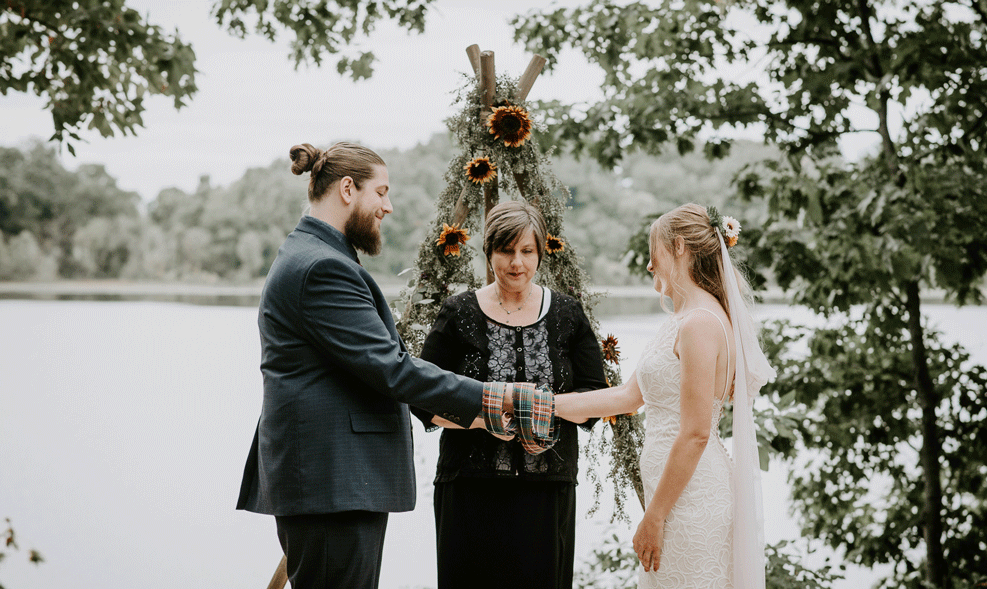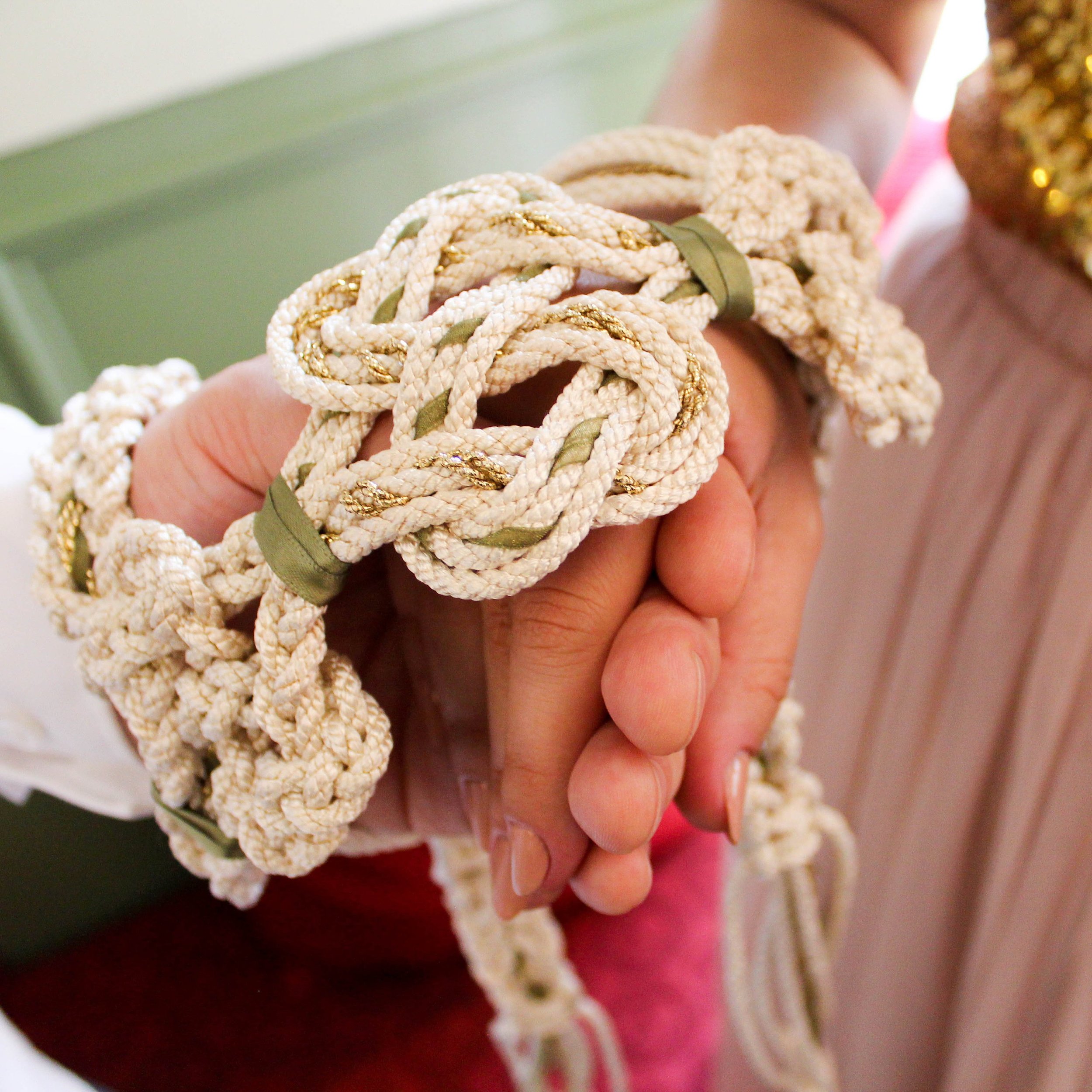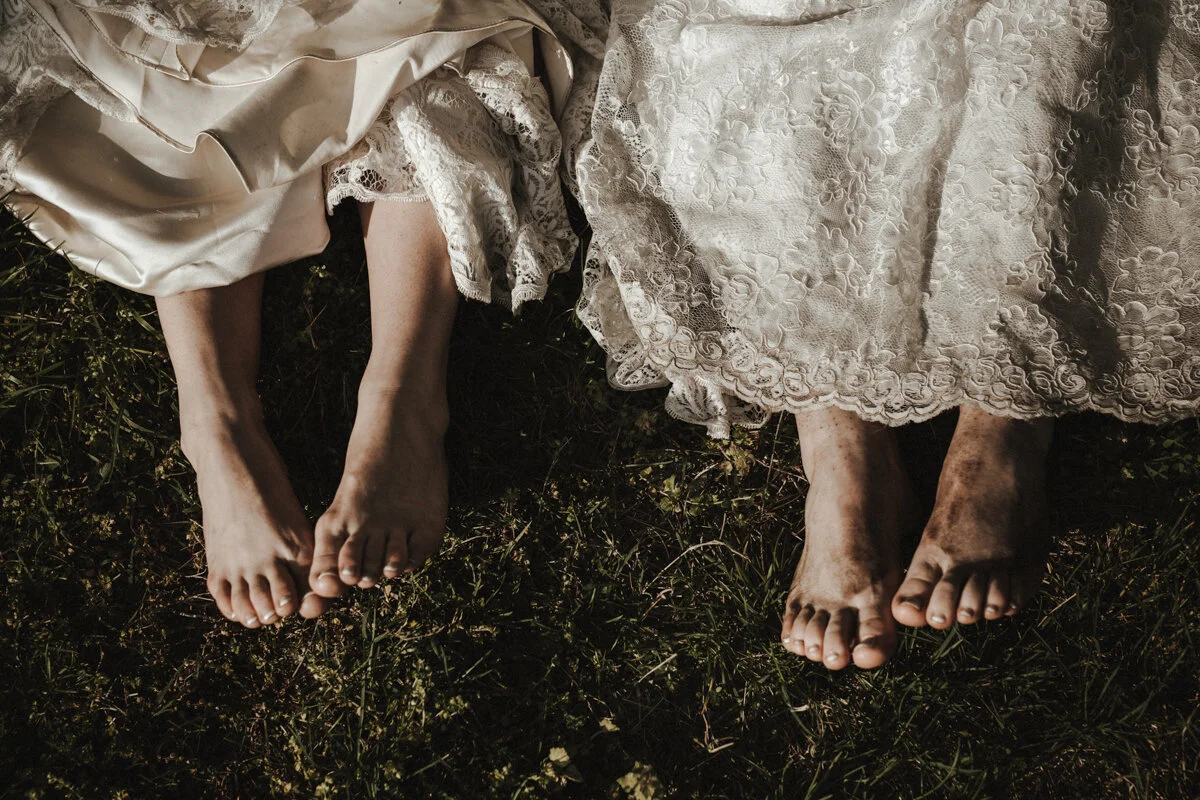Handfasting at Weddings: Why It’s Not Just For Pagans and Witches
/Handfasting Wedding Ceremony. Photo By Liv Lyszyk Photography
Catalyst Wedding Co. may receive compensation or products from companies mentioned in this article. This helps support our site.
Handfasting is a marriage unity ritual that has been used during weddings for centuries. Like many other unity rituals, such as unity candles or sand rituals, it represents the combination of two people coming together to create a new singular entity. A couple joins their hands together and they are wrapped with a ribbon or cord. If done in the traditional way, as the couple separates their hands they literally tie the knot (hence the origin of the phrase), and are joined together in their commitment to each other.
Handfasting isn’t a ceremony that we are used to seeing in traditional Western or Christian-centric weddings. While it has Celtic origins, it is a ritual that has largely only been used by Pagans and Wiccans since the 1960s. But this isn’t a ritual just for those that identify as Pagans, Wiccans, or witches. Anyone can take part in this meaningful and visually beautiful ritual.
So Where Did the Practice of Handfasting Come From?
When the term was first used in rural Scotland, two people would form a contract by joining hands. We’ve talked before about how important it is to remember that marriage is a contract. It’s an agreement you and your partner are making to each other about your future together, and we encourage you and your partner to talk candidly about what you expect from each other.
Back when most people lived in small rural villages, you might not always have access to a government or religious official who could oversee your marriage. In some Pagan groups, you also might not have the same hierarchy of religious figures as we see with ordained ministers and priests in Christianity. The ritual of handfasting was accessible to all, and still held the same weight, validity, and importance as any of our modern-day ceremony practices.
“I like how unique it is,” says Michigan photographer Liv Lyszyk, “especially when they go through the meaning of each fold [of the cord]. It's really special.”
Handfasting Inspiration. Photo by Love to the Core Photo
The Ribbon or Cord You Choose Is Up to You
It is fun to add a personal flare by selecting or creating a ribbon or cord that is meaningful to you and your partner. You can cut a strip of fabric from the tattered picnic blanket you used on your first date. You can use material from an old family wedding dress that is too damaged to be worn. You can get super creative and embroider a piece of fabric with symbols, words, or scenes that mark major moments in your relationship.
“I had a couple include handfasing in their ceremony to honor their Scottish heritage and it was beautiful!” says Norfolk, Virginia photographer Tyler Adams of The Girl Tyler. “I love the physical binding to each other, equally paired with the emotional liturgy. They even made their own handfasting cord. It was beautiful!”
Not feeling crafty enough to make your own handfasting cord? Etsy has hundreds of options to choose from, including tartan, celtic knots, evergreens, or just about any other style or material you can imagine.
Your Guests Are All Treated as Equals
In more traditional handfasting ceremonies, guests are encouraged to form a circle around the couple. This is a common practice with most Pagan rites and rituals, and any clockwise movement in a circle is considered positive (deosil), while counter-clockwise movement is considered negative (widdenshins).
Having your guests form a circle means that there are no sides, no front seats, no back seats, and no spots reserved specifically for family. Your guests are all seen as equals in this ceremony, and are all there with the express purpose of supporting your union. Guests are also usually encouraged to join hands while in the circle, which, as a bonus, helps keep them focused and off their phones.
Whether Your Handfasting Ceremony Is Legal Is Up To You
People often ask whether or not handfasting is a legally binding wedding ceremony ritual. The answer is, it depends, and frankly, that’s by design.
Handfasting can absolutely be a part of a legally-binding wedding ceremony led by a certified officiant or wedding celebrant. It can also be a non-legally-binding commitment ceremony, and there a few reasons why that’s really awesome.
Handfasting has long been used as a tool to unify couples that have been denied access to legal marriage. Before the 2015 Obergefell SCOTUS decision, LGBTQ+ couples in the U.S. could use this wedding ritual as a way to join together in love and commitment, whether or not it was recognized by the government. Since its origins, it has often been used as a self-uniting practice, and we love that it takes the definition of love and marriage out of the hands of a governing body and rests it squarely with the couple, much like Quaker ceremonies do.
Another perk to this alternative ceremony is that it does not have to be a “‘till death do us part” commitment. If you choose to not make your ceremony legally binding, then you are free to specify any timeframe for your union that you like, and as we’ve discussed before, there are a lot of perks to this approach to marriage.
Handfasting Can Be As Secular or As Religious As You Want
While handfasting does have Pagan roots, it does not require you to reference any religious entities or works, and therefore is a great option for non-religious couples, or for couples who have a lot of non-religious family or guests. It can also be great for interfaith couples, as it is a neutral ceremony that doesn’t focus on any single religion over another.
“To me, it's a tradition that, unlike most, is really non-religious and secular,” says Portland, Oregon and St. Louis wedding planner Cindy Savage of Aisle Less Traveled. “I love that couples can use it to connect with marriage at an institutional and ritual level without having to bring god(s) or patriarchy into it.”
Cindy also points out that you can select friends of family members to come forward and take turns wrapping the cord around your hands.
“I find it to be quite lovely to involve loved ones in a literal hands-on way,” says Cindy. “It very visibly brings a community aspect into the concept of marriage when the couple's parents, wedding party, or other close loved ones bring a cord forward and do the physical act of wrapping their hands.”
No matter what approach you take to this ceremony, it is certainly a beautiful and meaningful way to start a marriage!
Looking for a handfasting ceremony script to use for your wedding? The Everyday Witch Book of Rituals by Deborah Blake includes both a casual and a formal Pagan handfasting script that you can adapt for your own ceremony.
Note that this particular handfasting script includes a prompt to jump the broom. While jumping the broom at your wedding does have some roots in Paganism, it is largely considered an African-American tradition in the U.S., and this tradition, when practiced by non-black couples, is usually considered cultural appropriation. Unless you or your partner are black, we encourage you to skip this part of the ceremony script.
JEN SIOMACCO
Jen Siomacco is the CEO and Creative Director of Catalyst Wedding Co. She works to mesh together her love of feminism, love stories, equality and design into the layout and brand of Catalyst while she sits on her couch and snuggles up with her SUPER lazy cats.
























